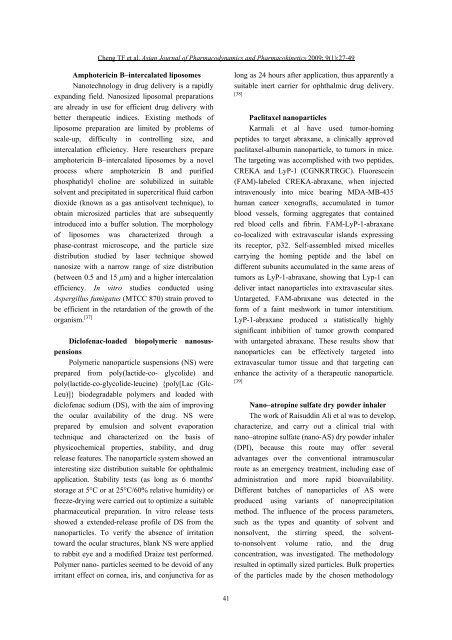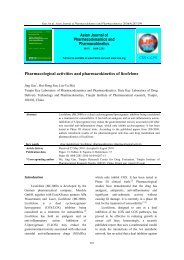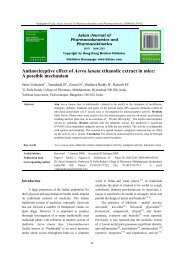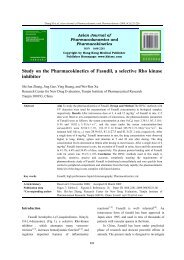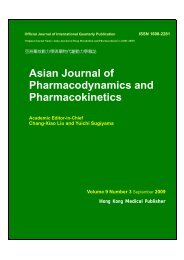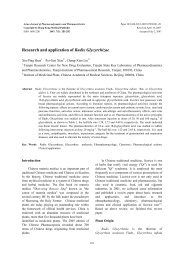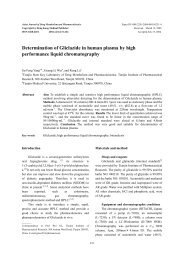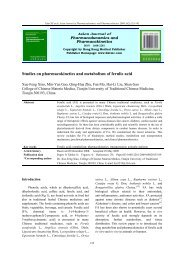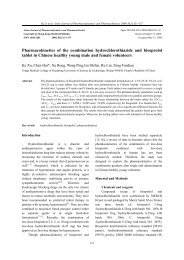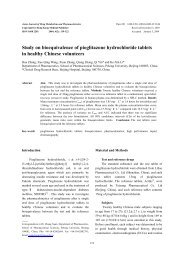Asian Journal of Pharmacodynamics and Pharmacokinetics
Asian Journal of Pharmacodynamics and Pharmacokinetics
Asian Journal of Pharmacodynamics and Pharmacokinetics
You also want an ePaper? Increase the reach of your titles
YUMPU automatically turns print PDFs into web optimized ePapers that Google loves.
Cheng TF et al. <strong>Asian</strong> <strong>Journal</strong> <strong>of</strong> <strong>Pharmacodynamics</strong> <strong>and</strong> <strong>Pharmacokinetics</strong> 2009; 9(1):27-49<br />
Amphotericin B–intercalated liposomes<br />
Nanotechnology in drug delivery is a rapidly<br />
exp<strong>and</strong>ing field. Nanosized liposomal preparations<br />
are already in use for efficient drug delivery with<br />
better therapeutic indices. Existing methods <strong>of</strong><br />
liposome preparation are limited by problems <strong>of</strong><br />
scale-up, difficulty in controlling size, <strong>and</strong><br />
intercalation efficiency. Here researchers prepare<br />
amphotericin B–intercalated liposomes by a novel<br />
process where amphotericin B <strong>and</strong> purified<br />
phosphatidyl choline are solubilized in suitable<br />
solvent <strong>and</strong> precipitated in supercritical fluid carbon<br />
dioxide (known as a gas antisolvent technique), to<br />
obtain microsized particles that are subsequently<br />
introduced into a buffer solution. The morphology<br />
<strong>of</strong> liposomes was characterized through a<br />
phase-contrast microscope, <strong>and</strong> the particle size<br />
distribution studied by laser technique showed<br />
nanosize with a narrow range <strong>of</strong> size distribution<br />
(between 0.5 <strong>and</strong> 15 µm) <strong>and</strong> a higher intercalation<br />
efficiency. In vitro studies conducted using<br />
Aspergillus fumigatus (MTCC 870) strain proved to<br />
be efficient in the retardation <strong>of</strong> the growth <strong>of</strong> the<br />
organism. [37]<br />
Dicl<strong>of</strong>enac-loaded biopolymeric nanosuspensions<br />
Polymeric nanoparticle suspensions (NS) were<br />
prepared from poly(lactide-co- glycolide) <strong>and</strong><br />
poly(lactide-co-glycolide-leucine) {poly[Lac (Glc-<br />
Leu)]} biodegradable polymers <strong>and</strong> loaded with<br />
dicl<strong>of</strong>enac sodium (DS), with the aim <strong>of</strong> improving<br />
the ocular availability <strong>of</strong> the drug. NS were<br />
prepared by emulsion <strong>and</strong> solvent evaporation<br />
technique <strong>and</strong> characterized on the basis <strong>of</strong><br />
physicochemical properties, stability, <strong>and</strong> drug<br />
release features. The nanoparticle system showed an<br />
interesting size distribution suitable for ophthalmic<br />
application. Stability tests (as long as 6 months'<br />
storage at 5°C or at 25°C/60% relative humidity) or<br />
freeze-drying were carried out to optimize a suitable<br />
pharmaceutical preparation. In vitro release tests<br />
showed a extended-release pr<strong>of</strong>ile <strong>of</strong> DS from the<br />
nanoparticles. To verify the absence <strong>of</strong> irritation<br />
toward the ocular structures, blank NS were applied<br />
to rabbit eye <strong>and</strong> a modified Draize test performed.<br />
Polymer nano- particles seemed to be devoid <strong>of</strong> any<br />
irritant effect on cornea, iris, <strong>and</strong> conjunctiva for as<br />
long as 24 hours after application, thus apparently a<br />
suitable inert carrier for ophthalmic drug delivery.<br />
[38]<br />
Paclitaxel nanoparticles<br />
Karmali et al have used tumor-homing<br />
peptides to target abraxane, a clinically approved<br />
paclitaxel-albumin nanoparticle, to tumors in mice.<br />
The targeting was accomplished with two peptides,<br />
CREKA <strong>and</strong> LyP-1 (CGNKRTRGC). Fluorescein<br />
(FAM)-labeled CREKA-abraxane, when injected<br />
intravenously into mice bearing MDA-MB-435<br />
human cancer xenografts, accumulated in tumor<br />
blood vessels, forming aggregates that contained<br />
red blood cells <strong>and</strong> fibrin. FAM-LyP-1-abraxane<br />
co-localized with extravascular isl<strong>and</strong>s expressing<br />
its receptor, p32. Self-assembled mixed micelles<br />
carrying the homing peptide <strong>and</strong> the label on<br />
different subunits accumulated in the same areas <strong>of</strong><br />
tumors as LyP-1-abraxane, showing that Lyp-1 can<br />
deliver intact nanoparticles into extravascular sites.<br />
Untargeted, FAM-abraxane was detected in the<br />
form <strong>of</strong> a faint meshwork in tumor interstitium.<br />
LyP-1-abraxane produced a statistically highly<br />
significant inhibition <strong>of</strong> tumor growth compared<br />
with untargeted abraxane. These results show that<br />
nanoparticles can be effectively targeted into<br />
extravascular tumor tissue <strong>and</strong> that targeting can<br />
enhance the activity <strong>of</strong> a therapeutic nanoparticle.<br />
[39]<br />
Nano–atropine sulfate dry powder inhaler<br />
The work <strong>of</strong> Raisuddin Ali et al was to develop,<br />
characterize, <strong>and</strong> carry out a clinical trial with<br />
nano–atropine sulfate (nano-AS) dry powder inhaler<br />
(DPI), because this route may <strong>of</strong>fer several<br />
advantages over the conventional intramuscular<br />
route as an emergency treatment, including ease <strong>of</strong><br />
administration <strong>and</strong> more rapid bioavailability.<br />
Different batches <strong>of</strong> nanoparticles <strong>of</strong> AS were<br />
produced using variants <strong>of</strong> nanoprecipitation<br />
method. The influence <strong>of</strong> the process parameters,<br />
such as the types <strong>and</strong> quantity <strong>of</strong> solvent <strong>and</strong><br />
nonsolvent, the stirring speed, the solventto-nonsolvent<br />
volume ratio, <strong>and</strong> the drug<br />
concentration, was investigated. The methodology<br />
resulted in optimally sized particles. Bulk properties<br />
<strong>of</strong> the particles made by the chosen methodology<br />
41


